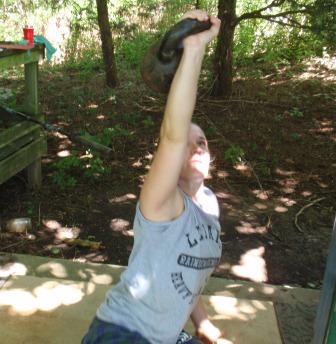Watch Your Back!
by Jarrod Fobes

Amber Glasgow, of the Ledaig Heavy Athletics Club, performs a Turkish Get Up with 35 pounds. The Turkish Get Up is a great exercise to strengthen muscle imbalances in the back.
Injuries have shaped a lot of my training, and there is nothing that will get you thinking more about how you train than an injured back. Bum knee? Work your upper body for a while. Injured shoulder? Train around it. Hurt your back? You won’t be in the gym for at least a few weeks. After my last back injury I got busy researching back health and learning what I could do to prevent any future relapses. From what I’ve learned, spinal “prehab” can be distilled down to two major factors. Here’s what they are and what you can do about them.
Muscle Imbalances
Muscle imbalance refers to any break in the symmetry of the muscular system. You don’t want your right side stronger than your left, or your front stronger than your back. Most of you have heard that to protect your back, you should strengthen your abdominals. Strong abdominals are important to provide a counter to the powerful muscles of the lower back, but they are only part of the equation. Is your left hip flexor stronger than the right? Then your hip may be pulled down on the left side, and your back will struggle to compensate for it. Are your hamstrings disproportionately stronger than your quads? That may have an effect on the stability of your knee. If your knee goes out, your hips may start compensating for your injured knee. From there the chain of compensation can easily reach your back.
Fortunately there are two exercises that are terrific for correcting major muscle imbalances. One is the Turkish Get-up, already and official USAWA lift. The other is the One Legged, One Armed Deadlift.
If you are balancing on your right leg, you will grab the weight with your left hand. Put a slight bend in the knee of your support leg. As you lean forward to grasp the weight, your non-support leg should rise up, keeping in as straight a line as possible with your back. Maintain that alignment as you stand up with the weight. As with any deadlift, don’t let your head droop forward.
Both lifts should be trained heavy, but not to failure. Within a month or two diligently giving each side of your body equal work with these lifts, you should have corrected the major imbalances in your body. But stay on guard against overworking one side or the other in day-to-day life too: if you ride a bike, don’t always push off with your dominate leg. If you carry a kid around, make sure you use both sides of your body for roughly equal time. You get the idea.
Muscle Endurance
Muscle endurance is the ability of a muscle to work for a prolonged period of time. It is related to, but separate from muscle strength, which most of us focus on in the gym. Many of us have strong backs, but inexplicably still have back problems. That’s because while we may be able to lift enormous loads with our backs, we haven’t conditioned them to handling sustained, symmetrical loads. Just as being able to do 100 push-ups may not translate into a huge bench press, heavy deadlifts do little to condition our backs to prolonged work. That is why kettlebell swings are so important.
Stand with your feet about shoulder width apart. You should have about a 90-degree bend in your knees, as well as at your waist. Do not let your back round, and keep your head up. The kettlebell (or whatever implement you decide to you use) will be in both hands tucked under your behind. Your wrists should rest on your inner thighs.
From this position, explode forward with your hips, extending the legs and back. The weight should stop at 12-o’clock, directly over head with your arms straight. A common mistake is to initiate the movement with the arms. The explosive hip extension should provide the momentum to get the weight moving. Guide the weight back down to the starting position, and repeat.
Since we’re focusing on muscle endurance, execute a high number of reps, at least 75. Focus on maintaining a high rep speed, too. This will mean starting with a lighter weight than most of us like to be seen with in the gym, but do it anyway. If 75 is too daunting, start with 3×25, and “steal” reps from the last set and give them to the first in following workouts. So following rep schemes might look like 35x25x15, 50×25, etc until you reach 75 reps. Once you can handle 75 you have the option of increasing weight or increasing reps. Besides muscle endurance, my posture has improved greatly since adding kettlebell swings to my routine. I recommend them to anyone whose shoulders roll forward. Another benefit of this exercise is the tremendous cardiovascular work it provides. If done with speed, explosiveness, and adequate weight, your heart will really be pumping by the end!